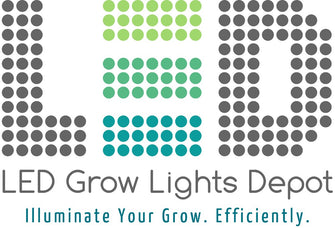Veteran-Owned. Free Shipping in the USA on nearly all items!
Call us: 888-611-9305
Veteran-Owned. Free Shipping in the USA on nearly ALL items!
We score 4.9 out of 5 based on 5274 reviews. Browse Reviews.

Updated: Jan 2023

If you are new to the wonderful world of LED grow lights, you might be in a haze trying to figure out how to choose the most practical light for your grow.
LED grow lighting is very different from a metal halide or a high-pressure sodium setup in that LED fixtures vary drastically in shape, spectrum, heat load, and power.
But fear not, this article will assist your LED grow light search—saving you time, money, and assuring you the highest quality crop.
This 3 step guide will cover:
Before you decide on an LED grow light, you must consider the type of plant you are working with. Most LED lights on the market will grow any plant from seed to flower.
The size of your grow space will dictate the size and number of an LED units you purchase. A good rule-of-thumb for LED grow lights is 40 watts of actual wattage per square foot of growing space for flowering medical or "high light" plants like tomatoes or peppers.
For example, if you measured your growing space to be 16 square feet, you would want to purchase around a 640 watt grow light (assuming the plants are congregated in a single area and you are flowering a plant that requires a lot of light.
Vegetative growth for high-light plants need about half this wattage). However, it is possible to use a 500 watt light in a 16 sq ft space or up to 800 watt depending on how hard you want to push your plants.
"Low light" plants, such as herbs and lettuces require about 11-18 watts per square foot of grow space. However, this will vary with crop and preferred light levels. Use this chart to determine the correct amount of PPFD and DLI for leafy greens.
Below is a quick reference chart designed to help you determine the desired wattage based on your grow space. If you have a larger grow space, you can scale up from these numbers. Remember: 1 sq ft of grow space requires about 40 watts of actual wattage. Wattage should only be used as an estimation.
| Grow Space | Wattage |
|
2 sq ft (2x1) |
80 |
|
4 sq ft (2x2) |
160 |
|
6 sq ft (2x3) |
240 |
|
9 sq ft (3x3) |
360 |
|
12 sq ft (3x4) |
480 |
|
16 sq ft (4x4) |
640 |
|
20 sq ft (4x5) |
800 |
|
25 sq ft (5x5) |
1000 |
By now, you might have an idea of what brand of LED grow lights would be best for your crop and how much light you need for your grow space. Now, you will discover the different LED unit options available to you.
If you are growing plants from seedling to flower you will want to purchase a full spectrum LED light. However, you may only need lights for vegging.
Most lights these days are fully dimmable, and some allow you to tune the spectrum. Wireless controlled lights are by far the most advanced LED grow lights that will make for an almost effortless grow. It is safe to say that the LED grow light industry is moving in the direction of fully automated fixtures.
In addition, there are different shaped LED grow lights available, including bar lights, slim greenhouse lights, and fluorescent replacement bulbs.
DIY kits are available for those who would like to assemble their own light.
Now that you have a brand, light requirements, and type of LED grow light in mind, you can start your LED grow light search. For questions about choosing your light, feel free to contact LED Grow Lights Depot or checkout our YouTube channel for more info on LED grow lights including reviews.
{"one"=>"Select 2 or 3 items to compare", "other"=>"{{ count }} of 3 items selected"}


